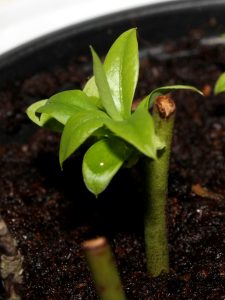Propagation of Blueberries by cuttings
Blueberry propagation is relatively easy and gives good results, but it takes at least a year to get a well rooted plant that can be planted to it’s final location.

Blueberries are usually propagated from softwood or hardwood cuttings by cutting twigs from healthy mother plants. Cuttings are then placed into soil, that holds moisture well and allows adequate aeration. Drainage is extremely important and in most cases cuttings fail to root, because of waterlogged soil which causes young fragile roots to rot. Softwood cuttings are usually taken during the late spring or early summer. Hardwood cuttings, on the other hand, can be obtained during winter dormancy in January or February in northern hemisphere.

Hardwood cuttings usually give better results than softwood cuttings, which are more delicate, can easily dessicate and are more susceptible to fungal infections and rot. To take hardwood cuttings, one year old shoots are used. It’s essential that the cuttings don’t have flower buds, if they do, you need to cut off the top part of the shoot. Flowers make rooting almost impossible, because they deplete the energy of the cutting faster than new roots can grow. Cuttings need to be 10 to 12 cm long. Bottom part of each cutting needs to be severed, to promote root growth. By peeling of 1 cm of bark on one side of the cutting should be enough. Place the cuttings into the soil so that the peeled bark ends up on the bottom in the substrate. You need to stick at least half of the cutting below soil level and only one or two leaf buds above the soil.

In a couple of months, cuttings form callus around the wounded tissue and it doesn’t take long before first roots appear and the cuttings take off. The roots are fragile in the beginning, so it’s essential to keep the rooting medium moist but not overly wet. It is essential to keep the cuttings protected from drying out at this phase. If everything goes well, first cuttings start swelling the buds on the shoots they initially grew in the beginning. The new growth indicates that the cuttings made their first roots. Those roots make it possible for them to acquire more nutrients and continue with growth. When their second growth phase is completed after the growth of new leaves and shoots ceases, it’s time to plant them into separate pots. Some of the cuttings never make it and I wouldn’t wait too long, before I transplant the ones that had rooted successfully.


7 thoughts on “Propagation of Blueberries by cuttings”
i took 5 dormant hardwood cuttings “tall bush blueberry” and its only been 2-3 weeks and i already see the “buds” beginning to open a bit. is this normal? I have them in the corner of my living room, indirect sunlight. it is winter here so inside temperate is around 67 degrees F. I hope it is not to soon. I have them in humid environment and mist once a day.
It’s not too early if you have them inside. I also started inside the last time and cuttings did OK. I haven’t kept them inside all the time, because I transferred the cuttings outside in the spring. They needed shade, so I place them into fully shaded location to prevent them from drying out.
67F (20°C) is great to start them. If the temperature was a bit lower, they would take longer to wake up, but it’s OK. When they start growing leaves the first time, they don’t have any roots yet, they just broke the dormancy and started growing with the nutrients and energy reserves stored inside the tissue. They will cease growing after they green-up and seemingly do nothing. At that point, cuttings will devote their energy into healing the scar below the soil and starting to grow roots. It will take quite some time before they finish.
I just took some cuttings as well, I’ll see if I can get them to root again. They are fully dormant and I’m keeping them under artificial light with my bamboo and Hibiscus moscheutos seedlings.
Good luck and please let me know how it goes!
This year I have taken a bit larger and even some older cuttings (2 year old wood). I’ll see if these can root as well. Still dormant after a week or so inside.

In case you’re still around. In three weeks, blueberry cuttings started leafing out. At this point, they will use nutrients, stored in the woody stem and use the small leaves to re-start and grow roots. If I remember correctly, they needed at least another month or more, before they started growing again. Second flush of growth wasn’t stunted and the branches elongated normally.
Hello,
Having read and shared your chestnut nut grafting article, several local nut growers are interested in your work.
Would it be possible to get more details?
Lacking live sphagnum moss is there a graft union protecting material you would recommend?
I would like to apply the technique to other nut trees. Hickory would be my first choice.
Currently in stratification are Grainger shagbark, Henry shellbark and some others.
I intend to graft Grainger scions into Grainger nuts if size permits.
Thank You,
SB
Following progress of tarzan. I too have started hardwood cuttings of blueberry. They are currently breaking dormancy.
How did it go? Are the cuttings still alive? The key is keeping them well hydrated and not overly wet. Soil needs to hold air for them to grow roots. Good luck!